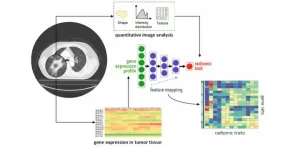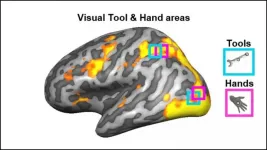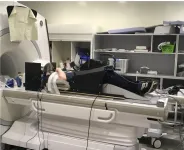(Press-News.org) UNIVERSITY PARK, Pa. -- Log on to any app store, and parents will find hundreds of options for children that claim to be educational. But new research suggests these apps might not be as beneficial to children as they seem.
A new study analyzed some of the most downloaded educational apps for kids using a set of four criteria designed to evaluate whether an app provides a high-quality educational experience for children. The researchers found that most of the apps scored low, with free apps scoring even lower than their paid counterparts on some criteria.
Jennifer Zosh, associate professor of human development and family studies at Penn State Brandywine, said the study -- recently published in the Journal of Children and Media -- suggests apps shouldn't replace human interaction nor do they guarantee learning.
"Parents shouldn't automatically trust that something marked 'educational' in an app store is actually educational," Zosh said. "By co-playing apps with their children, talking to them about what is happening as they play, pointing out what is happening in the real world that relates to something shown in an app, and selecting apps that minimize distraction, they are able to leverage the pillars of learning and can successfully navigate this new digital childhood."
According to previous research, about 98 percent of kids ages eight and under live in a home with some type of mobile device, like a smartphone or tablet. While watching videos and playing games are popular ways children spend their time on these devices, the researchers said there are also many apps that are not only popular but claim to be educational.
Marisa Meyer, a research assistant at the University of Michigan, said the idea for the study came about when reviewing the top-downloaded apps on the Google Play marketplace for different research.
"We noticed a concerning number of apps being marketed to children as 'educational' without reputable justification or verification of these educational claims," Meyer said. "Our study was an effort to create a coding scheme that would allow us to evaluate apps marketed as educational and have a framework to verify, or refute, those claims."
For the study, the researchers developed a system for evaluating educational apps that was based on Zosh's previous work in Psychological Science in the Public Interest, which used decades of research on the science of learning to uncover the "pillars" of learning - or the contexts and traits of truly educational experiences. In that piece, Zosh says, "we explored how these pillars might give us insight into how to leverage new technology to create truly educational experiences for young children.
In the current study, Zosh and the other researchers tested the apps children are actually using against these pillars to uncover what today's apps are doing well and where they struggle in supporting learning in young children. The researchers deemed an app high-quality based on how it performed across each pillar.
"The first pillar is to facilitate active, minds-on thinking in the children -- asking them to question, guess, evaluate, and think deeply, rather than simply tapping or reacting to on-screen stimuli," Zosh said. "The second is that it helps children stay tuned into the learning at hand, rather than distracting them with overwhelming sound effects, flash ads, and gimmicky rewards."
The researchers said the third pillar is containing relevant and meaningful content that facilitates a connection of app-based learning to the user's external world. Finally, the fourth pillar is that the app provides opportunities for social interaction, either in-person or mediated by the screen.
The top 100 children's educational apps from the Google Play and Apple app stores, as well as 24 apps most frequently played by preschool-age children in a separate longitudinal cohort study, were analyzed for the study. Each app was given a score of zero (low) to three (high) for each pillar. Apps that had a combined score of less than five after adding the scores for each pillar were considered low quality.
After analyzing the data, the researchers found that a score of '1' was the most common rating for all four pillars. For the fourth pillar -- Social Interaction -- a score of '0' was the second most common rating.
According to the researchers, because these apps might not provide high-quality educational experiences for kids, they risk parents choosing them over other activities -- such as reading, physical activity or pretend play -- that could actually be more beneficial.
Meyer added that the study also has implications not just for parents, but for app developers, as well.
"If app designers intend to engender and advertise educational gains through use of their apps, we recommend collaborating with child development experts in order to develop apps rooted in the ways children learn most effectively," Meyer said. "We also recommend that app designers and app stores work with child development experts to create evidence-based ratings of apps, so that higher-quality products with fewer distracting enhancements can be easily identified by parents."
INFORMATION:
Caroline McLaren, University of Michigan; Michael Robb, Common Sense Media; Harlan McCafferty, University of Michigan; Roberta Michnick Golinkoff, University of Delaware; and Kathy Hirsh-Pasek, Temple University, also participated in this work.
The National Institute of Child Health and Human Development helped support this research.
Recurrent, metastatic breast cancer resists treatment and is usually fatal.
These tumors often have low numbers of immune cells in them, which renders immune therapies less effective for the disease.
This preclinical study suggests that drugs called CDK4 and CDK6 inhibitors may make immune-cell therapies an effective option for treating recurrent ER-positive metastatic breast cancer.
COLUMBUS, Ohio - A class of drugs that inhibits breast cancer progression when used with hormonal therapy might also boost the effectiveness of immune therapy in cases of recurrent, metastatic breast cancer, according to a new study led by researchers at The Ohio State University Comprehensive Cancer Center - Arthur G. James Cancer Hospital ...
A new survey led by researchers from North Carolina State University found that the future of hunting in the United States might look different than it has in the past.
In The Journal of Wildlife Management, researchers reported findings from a nationwide survey of college students' interest and participation in hunting. They found current, active hunters were more likely to be white, male and from rural areas, and to have family members who hunted. But they also found a group of potential hunters - with no hunting experience but an interest in trying it - who were more diverse in terms of gender, ...
Despite our remarkable advances in medicine and healthcare, the cure to cancer continues to elude us. On the bright side, we have made considerable progress in detecting several cancers in earlier stages, allowing doctors to provide treatments that increase long-term survival. The credit for this is due to "integrated diagnosis," an approach to patient care that combines molecular information and medical imaging data to diagnose the cancer type and, eventually, predict treatment outcomes.
There are, however, several intricacies involved. The correlation of molecular patterns, such as gene expression and mutation, with image features (e.g., how a tumor appears in a CT scan), is ...
HOUSTON - (May 10, 2021) - Implants that require a steady source of power but don't need wires are an idea whose time has come.
Now, for therapies that require multiple, coordinated stimulation implants, their timing has come as well.
Rice University engineers who developed implants for electrical stimulation in patients with spinal cord injuries have advanced their technique to power and program multisite biostimulators from a single transmitter.
A peer-reviewed paper about the advance by electrical and computer engineer Kaiyuan Yang and his colleagues at Rice's Brown School of Engineering won the best paper award at the IEEE's Custom Integrated Circuits Conference, held virtually in the last ...
According to the International Whaling Commission, whale-watching tourism generates more than $2.5 billion a year. After the COVID-19 pandemic, this relatively safe outdoor activity is expected to rebound. Two new studies funded by a collaborative initiative between the Smithsonian Tropical Research Institute (STRI) in Panama and Arizona State University (ASU) show how science can contribute to whale watching practices that ensure the conservation and safety of whales and dolphins.
"The Smithsonian's role is to provide scientific advice to policy makers as they pioneer management strategies to promote whale conservation," said STRI marine biologist, Hector Guzmán, whose previous work led the International Maritime Organization to establish shipping corridors ...
ATLANTA--Gestures--such as pointing or waving--go hand in hand with a child's first words, and twins lag behind single children in producing and using those gestures, two studies from Georgia State University psychology researchers show.
Twins produce fewer gestures and gesture to fewer objects than other children, said principal researcher Seyda Ozcaliskan, an associate professor in the Department of Psychology. Language use also lags for twins, and language--but not gesture--is also affected by sex, with girls performing better than boys, Ozcaliskan said.
"The implications are fascinating," said Ozcaliskan. ...
MISSOULA - University of Montana Professor Mark Hebblewhite has joined an international team of 92 scientists and conservationists to create the first-ever global atlas of ungulate (hoofed mammal) migrations.
Working in partnership with the Convention on the Conservation of Migratory Species of Wild Animals, a U.N. treaty, the Global Initiative on Ungulate Migration (GIUM) launches May 7 with the publication of a commentary in Science titled " END ...
Visual brain areas involved in processing hands also encode information about the correct way to hold tools, according to new research published in JNeurosci.
Each part of the brain's visual system activates in response to a certain type of item -- whether it's faces, tools, objects, or hands. Scientists assumed the brain segregates visual information in this way to optimize motor actions with tools. Yet most studies investigating the brain mechanisms for tool grasping used images of tools or hands, and no actual hand movements were performed.
Knights et al. used fMRI to measure the brain activity of participants as they grasped 3D-printed kitchen tools (spoon, knife, and pizza cutter) and similar-sized non-tools. ...
Researchers at the University of East Anglia have made an astonishing discovery about how our brains control our hands.
They used MRI data to study which parts of the brain are used when we handle tools, such as a knives.
They read out the signal from certain brain regions and tried to distinguish when participants handled tools appropriately for use.
Humans have used tools for millions of years, but this research is the first to show that actions such grasping a knife by its handle for cutting are represented by brain areas that also represent images of human hands, our primary 'tool' for interacting with the world.
The research ...
Imaging technology has come a long way since the beginning of photography in the mid-19th century. Now, many state-of-the-art cameras for demanding applications rely on mechanisms that are considerably different from those in consumer-oriented devices. One of these cameras employs what is known as "single-photon imaging," which can produce vastly superior results in dark conditions and fast dynamic scenes. But how does single-photon imaging differ from conventional imaging?
When taking a picture with a regular CMOS camera, like the ones on smartphones, ...






